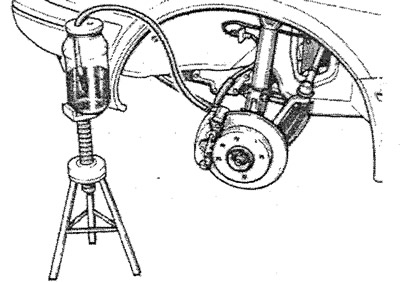For vehicles with anti-lock brakes: if one of the chambers of the brake fluid reservoir is completely empty (for example, in case of leaks in the brake system or if the mechanic forgot to add fluid to the reservoir when bleeding air from the brakes), then you need to carry out the procedure for removing air in the workshop. There, they will clear the trouble codes from the self-diagnosis unit and carry out the procedure for bleeding the air from the hydraulic block of the anti-lock system.
In the workshop, air from the brakes is usually removed using a special device for pumping liquid under pressure. On vehicles with an anti-lock brake system, ensure that the fluid supply pressure is not more than 1 bar.
You can do without a device for removing air. In this case, air is removed from the system using «swings» brake pedal, for which you need an assistant.
If air must be removed from the entire system, then the brakes of each wheel are pumped separately. This is done if air has entered each wheel cylinder. If only one brake caliper or wheel brake cylinder has been replaced or repaired, it is enough to bleed air from this cylinder (caliper).
Bleeding sequence (pumping):
Ford Fiesta/Mazda 121:
- 1. Front left wheel caliper.
- 2. Front right wheel caliper.
- 3. Rear right wheel caliper.
- 4. Rear left wheel caliper.
Ford KA:
- 1. Front left wheel caliper.
- 2. Rear right wheel caliper.
- 3. Front right wheel caliper.
- 4. Rear left wheel caliper.
Attention: In the process of work, it is necessary, from time to time, to observe the level of brake fluid in the reservoir. The level must not drop too low, otherwise air will enter the system through the tank. Always fill with fresh brake fluid.
Attention: Release the pressure in the system. To do this, press the brake pedal at least 20 times.

Precautions: when bleeding the rear brakes, carefully unscrew the valves (bolts) to remove air, because Brake fluid can be under very high pressure.
Attention: Remove the dust cap from the valve (bolt) to remove air. Clean the valve, put a clean hose on it, and lower the other end of the hose into a container partially filled with brake fluid. Capacity (bottle) should be about 30 cm above the valve so that the hose is filled and air does not enter the caliper through the valve threads.
Contrary to the picture, the car must be on a flat surface on wheels when the brakes are bled. Carefully unscrew the bleeder valve so as not to damage it. It is recommended to apply a rust-dissolving compound to the valve two hours before starting the bleed procedure. If the valve does not unscrew, then it is better to carry out the operation in the workshop.
Have an assistant depress the brake pedal several times to build up pressure in the brake system. This will be felt by the increased effort on the pedals.
When sufficient pressure has been built up, fully depress the brake pedal and hold it in that position.
Loosen the bleeder valve on the caliper with a ring wrench about half a turn. Collect escaping brake fluid in a container. Make sure that the end of the hose in the container is constantly immersed in brake fluid.
As soon as fluid stops coming out of the hose, tighten the valve.
Repeat the inflation process until pressure builds up. Depress the brake pedal and hold it in the down position. Unscrew the valve, wait until the liquid stops coming out, tighten the valve.
Repeat the bleed process on the brake wheel cylinder until no air bubbles remain in the fluid coming out of the hose.
After venting, remove the hose from the valve and put a dust cap on it.
Bleed the brake cylinders of the remaining wheels in the same way, following the above sequence.
After the end of the procedure, fill the tank to the mark «MAX» and close it.
Conduct a security check.
Security check
Are the bleed valves tight?
Is there enough brake fluid?
Carry out a density test with the engine running. To do this, press the brake pedal with a force of 200-300 N (20-30 kg) should not fall for about 10 seconds. Check tightness: all connections.
In conclusion, brake the car several times on a road with little traffic.
Do not reuse brake fluid that has been pumped out of the system.
